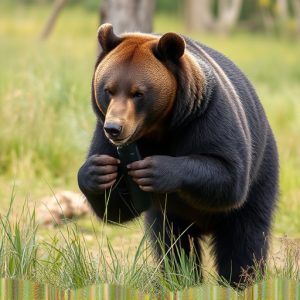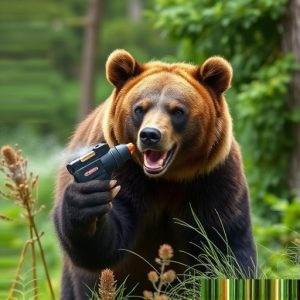Maximizing Bear Spray’s Stopping Power: Understanding Capsaicin’s Role
Bear spray's effectiveness against aggressive bears hinges on capsaicin concentration, typicall…….
Bear spray's effectiveness against aggressive bears hinges on capsaicin concentration, typically 1% to 3%, which disrupts their senses. Higher concentrations enhance stopping power but are influenced by weather and bear species. Choosing bear spray with suitable capsaicin levels (2% – 4%) for specific encounters and following best practices ensures maximum protection during potential bear interactions.
“In regions where bears roam, knowing how to defend yourself is crucial. This is where bear spray emerges as a vital tool, offering a non-lethal yet powerful deterrent. Our article unravels the effectiveness of bear spray, focusing on the active ingredient, capsaicin. We explore its scientific basis, dissect ‘maximum stopping power’ claims, and uncover factors affecting performance. Additionally, we provide best practices for safe and effective use. Understanding the capsaicin concentration in bear repellent is key to ensuring your safety during encounters with these majestic yet potent creatures.”
- Understanding Bear Spray: A Vital Self-Defense Tool
- The Science Behind Capsaicin and Its Efficacy
- Decoding Label Claims: What Does 'Maximum Stopping Power' Mean?
- Factors Influencing Bear Spray Performance
- Best Practices for Effective Use and Safety Measures
Understanding Bear Spray: A Vital Self-Defense Tool
Bear spray, also known as bear repellent, is a crucial self-defense tool for anyone venturing into bear country. It’s designed to deter aggressive bears when used correctly, giving users precious time to escape or defend themselves. Understanding how bear spray works and its maximum stopping power is essential for anyone looking to protect themselves in potential bear encounters.
The primary active ingredient in most bear sprays is capsaicin, the same compound that gives chili peppers their heat. The concentration of capsaicin in bear repellent varies significantly among brands, typically ranging from 1% to 3%. This concentration plays a vital role in determining the spray’s effectiveness. A higher capsaicin concentration generally means stronger stopping power, as it irritates the bear’s eyes, nose, and throat, causing it to retreat. Choosing a bear spray with an appropriate capsaicin level for the specific bear species and environmental conditions you’re facing is key to ensuring its maximum stopping power during a potentially dangerous encounter.
The Science Behind Capsaicin and Its Efficacy
The Science Behind Capsaicin and Its Efficacy
Bear spray, a powerful defense mechanism against aggressive bears, relies on an active ingredient known as capsaicin. This chemical compound is found in chili peppers and is responsible for their spicy heat. In bear repellent formulations, capsaicin concentration plays a critical role in determining its effectiveness. The key lies in its ability to disrupt the sensory systems of bears, specifically targeting their olfactory (sense of smell) and respiratory pathways.
When a bear’s nose comes into contact with the spray, capsaicin irritates the specialized receptors responsible for detecting odors. This stimulation triggers a response that leads to temporary blindness, disorientation, and intense discomfort. The high concentration of capsaicin in bear spray ensures its stopping power, allowing individuals to create enough distance from an approaching bear to ensure safety.
Decoding Label Claims: What Does 'Maximum Stopping Power' Mean?
Understanding the claims on bear spray labels is crucial when selecting an effective defense against aggressive bears. The term “maximum stopping power” often appears on product packaging, but what does it entail? This phrase typically refers to the concentration of capsaicin, the active ingredient in bear repellent sprays.
Capsaicin Concentration in Bear Repellent directly correlates with its potency and range. Higher concentrations mean a stronger irritant effect, potentially giving users more time to escape or deter an attack. Manufacturers often advertise their products as having “maximum stopping power” to highlight the spray’s ability to incapacitate or stop a bear in its tracks. However, it’s essential for consumers to interpret these claims critically, ensuring they choose a product suitable for the specific bear encounter risks they face.
Factors Influencing Bear Spray Performance
The effectiveness of bear spray as a defense mechanism is influenced by several key factors, with one of the most crucial being the capsaicin concentration in the repellent. Capsaicin, the active ingredient in chili peppers and many bear sprays, disrupts the bear’s sensory system, temporarily blinding and disorienting them. A higher capsaicin concentration generally translates to a more potent spray, offering increased stopping power against aggressive bears.
Other factors, such as weather conditions and the type of bear encountered, can also play a role in the spray’s performance. For instance, wet or windy conditions might reduce the range and effectiveness of the spray, while black bears may be less affected by capsaicin than grizzly bears due to differences in their sensory thresholds. Knowing these variables allows users to make informed decisions when choosing bear spray for specific situations.
Best Practices for Effective Use and Safety Measures
To maximize the stopping power of bear spray, it’s crucial to adhere to best practices for its effective use and prioritize safety measures. Firstly, always ensure that you’re using a high-quality, reputable bear repellent containing a strong capsaicin concentration—typically between 2% and 4%. This active ingredient is what triggers a bear’s natural aversion response. Secondly, familiarize yourself with the spray’s range and wind conditions; aiming for the face and eyes of an approaching bear increases the likelihood of deterring it. Practice holding the can firmly and spraying in short bursts to maximize accuracy and minimize wastage.
Safety should never be compromised when carrying bear spray. Store it securely out of reach of children and pets, and ensure everyone who accompanies you understands how to use it responsibly. Regularly inspect the spray for any signs of damage or degradation, and replace it according to the manufacturer’s guidelines. Remember, while bear spray is a valuable defense tool, it’s best to avoid encounters by making noise when hiking in bear country and keeping food securely stored.
Bear spray, powered by capsaicin, offers a highly effective self-defense mechanism against aggressive bears. Understanding the science behind its potency, decoding label claims, and adhering to best practices ensures optimal performance. The concentration of capsaicin in bear repellent plays a crucial role in deterring and neutralizing threats. By following safety measures and employing these defensive tools responsibly, individuals can navigate bear country with enhanced confidence and peace of mind.


